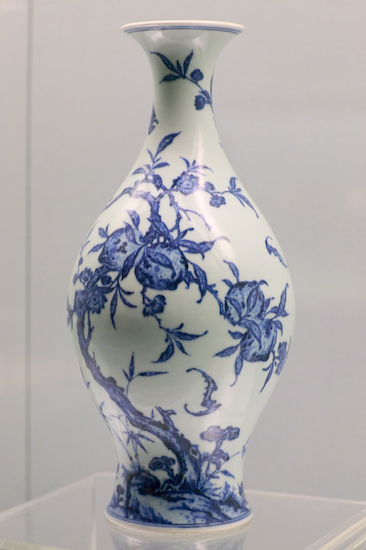National Peach Day: Chinese Art
Although not an officially designated national day, it is recognized by the National Day Calendar to celebrate the famous summer fruit. Peaches have been cultivated in the US since the 1600s with the arrival of European immigrants. National Peach Day is tied to the 1982 official recognition of National Peach Month, which is August.
National Peach Day, 27 August: Art by a Chinese Ceramic Artist
Chinese blue-and-white porcelain reached the peak of perfection in the mid-1700s.
 China, Qing Dynasty (1644–1912), Vase with peach decoration, from Yucun, Henan Province, 1723–1735. Bacun-ware glazed porcelain Shanghai Museum. Image © Dr Ron Wiedenhoeft/Saskia, Ltd. (MCC-1041) China, Qing Dynasty (1644–1912), Vase with peach decoration, from Yucun, Henan Province, 1723–1735. Bacun-ware glazed porcelain Shanghai Museum. Image © Dr Ron Wiedenhoeft/Saskia, Ltd. (MCC-1041) |
The imperial ceramic kilns at Jingdezhen were largely destroyed during the wars that resulted in the end of the Ming (1368–1644) and beginning of Qing (1644–1912) dynasties. The Manchu Qing rulers were enthusiastic art patrons, and the kilns were rebuilt by 1683. The peak of Chinese porcelain production occurred between 1661 and 1796, when the export of Chinese wares to the West boomed./p>
During the reign of the Kangxi Emperor (ca. 1662–1722), the quality of cobalt blue used in porcelain decoration was at its peak. From the Kangxi until the second half of the reign of the Qianlong Emperor (1735–1799), blue-and-white wares were unequaled in quality. This was due in part to the personal attention to vessel shapes and decoration by the emperors themselves, and the institution of paid artists rather than forced labor of the old imperial kilns.
The wares from this period are renowned for landscape and figurative decoration, rather than abstractions of flora. There are more nuances in the cobalt designs than previously or thereafter. Designs such as this were often copies from prints or paintings. The landscape of this vase depicts a peach tree. Peaches were considered the "fruit of immortality", representing wishes for a long and healthy life. Growing on the base of the peach tree trunk are lingzhi mushrooms. Lingzhi represents a combination of spiritual potency and essence of immortality, and is regarded as the “herb of spiritual potency,” symbolizing success, well-being, divine power, and longevity.
Pottery making can be dated in China as far back as 3000 BCE. While porcelain was produced in northern China, the predominant type of ceramic was stoneware, used by peasant and aristocrat alike. Porcelain was first produced in China in the 600s or 700s CE. In the south, porcelain was the preferred ware by all classes.
By the end of the Song Dynasty (ca. 1279 CE), northern kilns were also producing porcelain. Porcelain was first produced in China in the 600s or 700s CE. It was made of kaolin (which is decayed feldspar), powdered feldspar, or decomposed granite. It is a hard paste which must be fired very hot (1400 degrees Celsius).
Of the many art forms perfected during the Song Dynasty, ceramics were the greatest next to painting. After the development of high-fire wares during the Tang Dynasty (618–907 CE) and the first true porcelain, improvements continued to be made in the refinements and control of glazes.
The Chinese definition of porcelain has the following qualities: 1) the body must coalesce (blend) with the glaze; 2) when struck with a hard instrument, the body must produce a clear, resonant tone.

Comments